You may not know that your heart has an electrical system that controls its heartbeat, but this system is essential to your health. An abnormal heart rhythm (arrhythmia) can be deadly. A pacemaker is implanted to help keep the heart beating at a life-sustaining rhythm and rate when the natural electrical system isn’t working properly,.
At Cardiac and Vascular Consultants, our specialists provide the best possible care for our patients. Our consultants hold expertise in a wide variety of heart conditions and treatments, including pacemaker placement for arrhythmia. We offer outstanding cardiac care to residents in Florida from our various locations.
Below our expert cardiologists provide you with information about pacemakers and the lifesaving benefits they offer, in case you should ever need one.
What is a pacemaker?
An implantable pacemaker is a small device that is placed under the skin to help regulate the heart rate. The pacemaker has a generator that sends electrical signals to the heart, and leads that connect the generator to the heart. This device can help people with arrhythmias by normalizing their heart rate.
Some newer pacemaker models come with a leadless variety that are implanted directly into the heart. These models can also detect breathing rate and body motion, and thus can increase your heart rate as necessary during exercise.
Why is a pacemaker needed?
Conditions that may require pacemaker placement include bradycardia (when the heart beats too slowly), tachy-brady syndrome (which occurs when the heart alternates between fast and slow beats), tachycardia (when the heart beats too quickly), and heart block (caused by malfunction in your natural electrical system). A cardiologist may also recommend a special biventricular pacemaker for advanced heart failure.
When you have heart failure, one or both of your lower heart chambers (ventricles) aren’t able to pump the blood your body needs to function normally. A biventricular pacemaker sends signals to the ventricles to help the heart pump better. This type of treatment is also called cardiac resynchronization therapy (CRT). CRT can improve your heart’s pumping function and help relieve symptoms of heart failure.
Post-insertion Aftercare
During a pacemaker procedure, patients are sedated but they are awake. The procedure usually only requires one day or less in the hospital. Every few months, your doctor will check your pacemaker remotely. The pacemaker’s computer chip will transmit information about your pacing requirements, the device’s battery life, etc. to your doctor. Note that the batteries usually last for about 15 years before they need to be replaced.
Significant improvement in your overall health with less dizziness, fatigue, and other debilitating symptoms caused by an irregular heart rate and/or heart failure are also experienced post insertion of the pacemaker.


